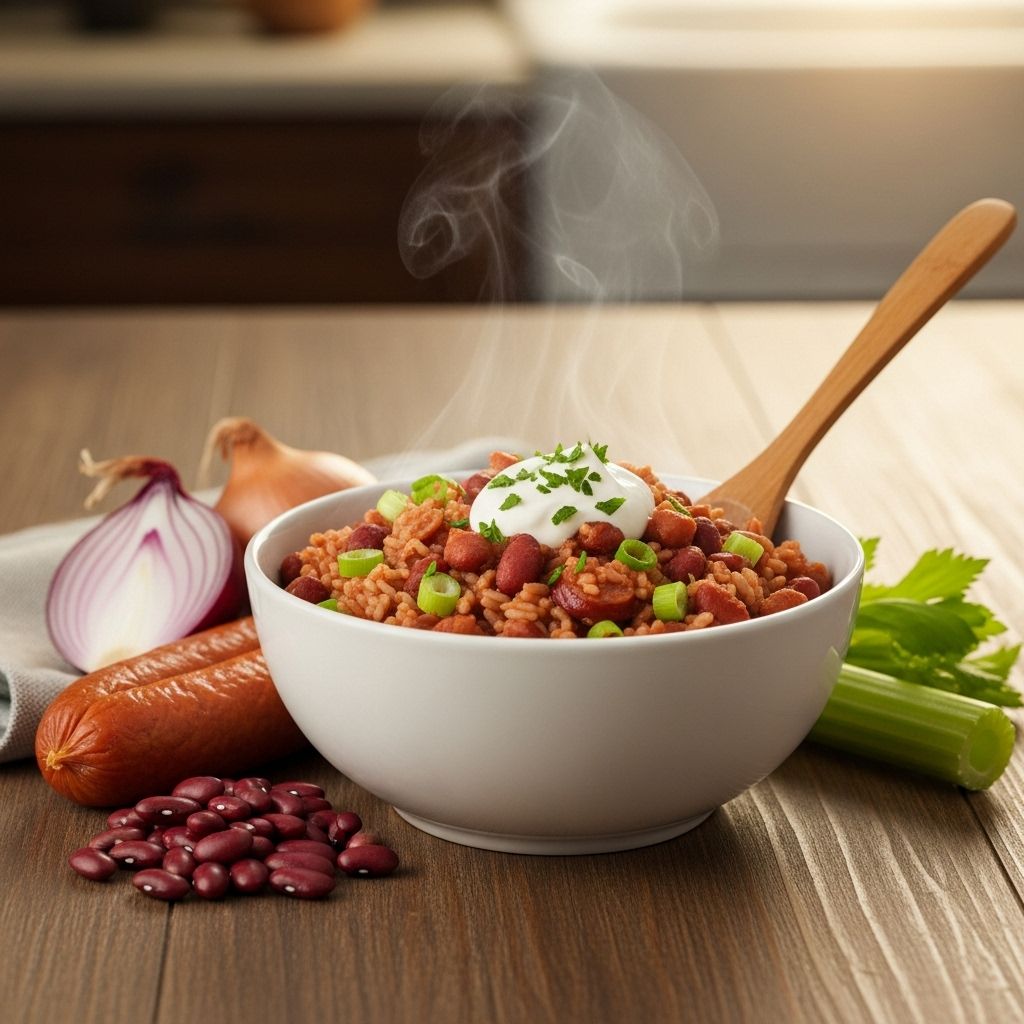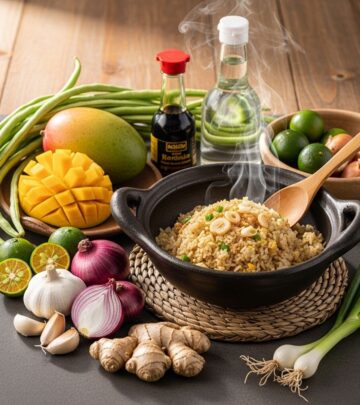Louisiana Red Beans And Rice Recipe: Easy Step-By-Step Guide
Discover the time-honored method for creating the most flavorful red beans and rice straight from Louisiana kitchens

Image: HearthJunction Design Team
Introduction to Authentic Louisiana Red Beans and Rice
Louisiana red beans and rice stands as one of the most iconic dishes in Cajun and Creole cuisine. This hearty, flavorful meal has deep roots in New Orleans culture, traditionally prepared on Mondays using Sunday dinner’s leftover ham bone. What makes this dish truly special isn’t just its incredible taste, but the loving, unhurried preparation that transforms simple ingredients into something extraordinary. This authentic recipe stays true to tradition, avoiding shortcuts that would compromise the dish’s signature creamy texture and rich flavor profile.
The beauty of Louisiana red beans and rice lies in its perfect balance of simplicity and complexity. While the ingredients are humble and budget-friendly, the layering of flavors and the slow-cooking process create a dish that’s greater than the sum of its parts. Every Louisiana family has their own version, passed down through generations, with subtle variations that make each pot unique. What remains constant is the dedication to doing things the right way – no shortcuts allowed.
The History and Cultural Significance
Red beans and rice has deep historical significance in Louisiana cuisine, particularly in New Orleans. The dish emerged as a practical solution for housewives who needed a meal that could simmer unattended on washing day (traditionally Monday). The long, slow cooking process was perfect for a day when household chores demanded attention elsewhere. Using leftover ham or ham bones from Sunday dinner was economical and flavorful.
Today, this dish remains a staple in Louisiana homes and restaurants, representing not just delicious comfort food but a connection to cultural heritage. The tradition of serving red beans and rice on Mondays continues in many establishments throughout New Orleans, honoring this culinary legacy. What began as a practical weekday meal has evolved into one of the most beloved dishes in Southern cuisine, celebrated for both its flavor and its cultural significance.
Essential Ingredients for Authentic Red Beans and Rice
The foundation of great Louisiana red beans and rice begins with quality ingredients. While variations exist, these core components are non-negotiable for an authentic preparation:
The Beans
The star of the show is dried red kidney beans, with many Louisiana natives swearing by the Camellia brand specifically. These beans, when properly soaked and slowly cooked, develop a creamy texture while maintaining enough structure to avoid becoming mushy. The overnight soaking process is crucial – it not only reduces cooking time but helps the beans cook more evenly and improves their digestibility.
The Holy Trinity
No Cajun or Creole dish would be complete without the ‘holy trinity’ of vegetables: onions, bell peppers, and celery. This flavor base, similar to French mirepoix or Spanish sofrito, provides the aromatic foundation for the dish. The vegetables should be diced to a uniform size for even cooking and proper texture in the finished dish.
The Meats
Traditional Louisiana red beans and rice incorporates several forms of pork, each adding distinct flavors:
- Andouille sausage: This smoked, heavily-spiced pork sausage provides a signature flavor that’s essential to authentic preparation
- Smoked ham hock or ham: Adds depth and a smoky dimension to the dish
- Bacon or salt pork: Often used to create the initial fat base for sautéing vegetables
Seasonings
The aromatic profile comes from a careful balance of herbs and spices:
- Bay leaves: Add subtle complexity during the long simmer
- Dried thyme and oregano: Provide earthy, herbal notes
- Garlic: Fresh minced garlic is essential for authentic flavor
- Cajun seasoning: A blend that typically includes paprika, cayenne, garlic powder, and other spices
Preparation Method: The No-Shortcuts Approach
What truly distinguishes authentic Louisiana red beans and rice is the methodical, unhurried preparation. This is not a dish to be rushed, as time allows flavors to develop and beans to achieve their perfect creamy consistency.
Soaking the Beans
Begin by sorting through the dried beans to remove any debris or damaged beans. Rinse them thoroughly in cold water, then place in a large bowl and cover with water by at least two inches. Allow the beans to soak overnight or for at least 8 hours. This crucial step reduces cooking time and helps the beans cook more evenly. After soaking, drain and rinse the beans again before cooking.
Building the Flavor Base
The cooking process begins with rendering fat from the pork products. In a large, heavy-bottomed pot or Dutch oven, cook diced bacon or salt pork until the fat is released. Then add sliced andouille sausage and brown it well to develop flavor. This initial step creates a rich foundation upon which the entire dish is built.
Next comes the holy trinity – sauté the diced onions, bell peppers, and celery in the rendered fat until they become translucent and aromatic. Add minced garlic during the final minute of sautéing, being careful not to let it burn. This vegetable base, properly prepared, is essential to achieving the authentic flavor profile.
The Long, Slow Simmer
Once the flavor base is established, add the soaked beans to the pot along with stock (chicken or vegetable), smoked ham, bay leaves, and dried herbs. Bring the mixture to a boil before reducing the heat to maintain a gentle simmer. This is where patience becomes the most important ingredient – the beans need to cook slowly for 2-3 hours, allowing them to gradually soften while absorbing the flavors in the pot.
Throughout the cooking process, stir occasionally to prevent sticking and check the liquid level, adding more stock if needed. The goal is a creamy consistency where some beans break down naturally to thicken the liquid while others remain whole. This textural contrast is a hallmark of properly prepared red beans.
Final Touches
During the last 30 minutes of cooking, taste and adjust seasonings with Cajun spice blend, salt, and pepper as needed. Some cooks mash a portion of the beans against the side of the pot to release starch and create a creamier texture. Fresh herbs like parsley or green onions can be added in the final minutes for brightness.
The Perfect Rice Accompaniment
While the beans are the star, properly prepared rice is essential to this dish. Long-grain white rice is traditional, cooked so each grain remains distinct rather than clumping together. The rice serves as both complement and canvas for the flavorful beans, soaking up the rich sauce perfectly.
Cook the rice separately while the beans simmer. The timing should allow both components to be ready simultaneously, with the rice freshly made when the beans are done. Authentic serving style places a scoop of rice in the center of a bowl with the beans ladled around and slightly over the rice.
Serving Suggestions and Accompaniments
Traditional Louisiana red beans and rice is often served with additional components that enhance the experience:
- Hot sauce – Crystal or Tabasco are traditional choices
- Cornbread or French bread for sopping up the sauce
- Sliced green onions as a fresh garnish
- Pickled vegetables for contrast
The dish is typically served in a bowl rather than on a plate, allowing the saucy beans to surround the rice. Some traditionalists insist that red beans and rice should never be mixed together before serving, though this rule is often broken once the meal begins.
Variations and Regional Differences
While respecting tradition, Louisiana red beans and rice does see variations across the region:
New Orleans-style preparation tends to be creamier, with beans cooked until some naturally break down. Creole versions might include tomatoes or tomato paste, while Cajun preparations typically do not. Some families add pickled pork instead of or in addition to ham and sausage. The level of spice varies dramatically between households, with some preferring a mild dish and others adding significant heat through cayenne or hot sauce.
Modern adaptations may include smoked turkey instead of pork for dietary preferences, though purists would argue this fundamentally changes the dish. The pressure cooker or Instant Pot has become a contemporary time-saving method, though traditional slow cooking develops deeper flavors.
Storing and Reheating
One of the greatest attributes of Louisiana red beans and rice is that it often tastes even better the next day, as flavors continue to meld and develop. Proper storage ensures you can enjoy these enhanced flavors:
Allow leftover beans to cool completely before refrigerating in airtight containers. They will keep well for 3-4 days. For longer storage, red beans freeze exceptionally well for up to 3 months. The rice, however, should be stored separately and fresh rice made for serving leftovers.
When reheating, add a small amount of water or stock to loosen the beans as they will thicken considerably when chilled. Warm slowly over medium-low heat, stirring occasionally to prevent scorching. This gentle reheating preserves the texture and prevents the beans from breaking down too much.
Frequently Asked Questions
Q: Why do my red beans never get creamy like restaurant versions?
A: The creaminess comes from long, slow cooking and using fresh dried beans. Old beans may never soften properly. Also, ensure you’re cooking long enough (at least 2 hours) and occasionally mashing some beans against the side of the pot to release their starch.
Q: Can I make authentic red beans and rice without pork products?
A: While traditional recipes use multiple pork products, you can create a flavorful version using smoked turkey or additional liquid smoke and vegetable stock. It won’t be traditional, but can still be delicious with proper seasoning.
Q: Is it necessary to soak the beans overnight?
A: For authentic results, yes. Soaking not only reduces cooking time but improves texture and digestibility. In a pinch, you can use the quick-soak method (boiling for 2 minutes, then soaking for 1 hour), but overnight soaking is preferred.
Q: What’s the difference between Cajun and Creole versions of this dish?
A: Creole versions may include tomatoes or tomato paste and tend to be served in New Orleans restaurants. Cajun versions, from rural Louisiana, typically omit tomatoes and might be spicier. Both are authentic but represent different Louisiana cooking traditions.
Q: Can I make this in a slow cooker or pressure cooker?
A: Yes, both methods work, though purists prefer the stovetop method. For slow cookers, sauté the trinity and meats first, then add to the cooker with beans and liquid for 8-10 hours on low. Pressure cookers can cook pre-soaked beans in about 30 minutes, but you may lose some of the depth of flavor that comes with slow cooking.
References
- https://www.allrecipes.com/recipe/58211/authentic-louisiana-red-beans-and-rice/
- https://laurenfromscratch.com/authentic-louisiana-red-beans-and-rice/
- https://www.budgetbytes.com/louisiana-red-beans-rice/
- https://www.butterbeready.com/louisiana-red-beans-and-rice/
- https://www.seriouseats.com/new-orleans-style-red-beans-rice-recipe
Read full bio of Srija Burman












